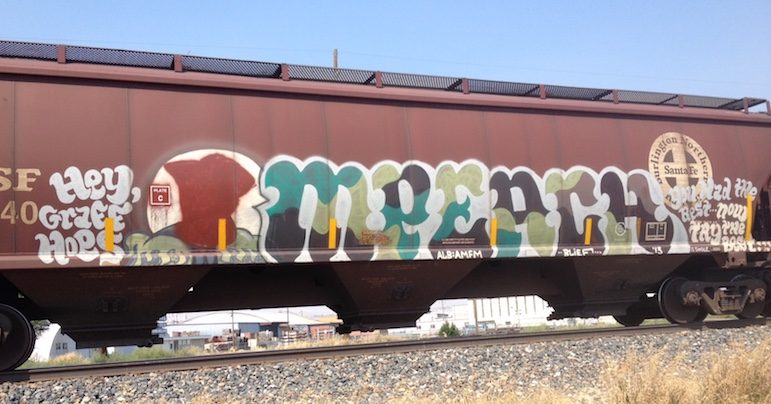Steve Prosinski permalink
Near grain silos in downtown Billings, a white rail car carries a blessing.
Last Best News (https://montana-mint.com/lastbestnews/2017/09/railcar-graffiti-an-eternally-traveling-art-show/)
Near grain silos in downtown Billings, a white rail car carries a blessing.
Demolish or Democrat? A question raised in Billings.
Near Laurel.
"Peas" painted on a car parked near Edgar.
Downtown Billings.
Dr. M art dwarfs other graffiti on this train creeping through Billings.
Does this say "cigar"?
Abe Lincoln Brigade (see Spanish Civil War) rolls through downtown Billings.
The Flyin Dagger sits on tracks near Edgar.
Some artists leave freight car information uncovered.
A colorful message in downtown Billings.
A social statement on tracks in downtown Billings.
The side of this rail car carries several statements in one painting.
Simple message on an oil tanker parked in Billings.
A complicated painting speaks of "snow." Cocaine?
Voice of America? Probably not.
The artist behind this work rolling into downtown Billings has a forever wish.
Parked in Billings, the red, white and blue carries a crude political message.

This piece ("Impeach") seen along Laurel Road possibly reflects its artist's political leaning, and adds, "You had the rest...now try the best."
On display from coast to coast and border to border, this traveling art show may be the biggest in the nation. Most certainly, it’s the heaviest.
For decades, railcar graffiti has been rolling across Montana around the clock, in all seasons, in all weather.
While the graffiti is free for the viewing, few people stop to study the colorful paintings – unless they’re stuck behind the wheel at a railroad crossing, patiently waiting as a long freight train chugs by.
But this is not free, engaging art in the eyes of all beholders. Railroad companies spend millions every year to remove graffiti, build and maintain fencing and security cameras, and patrol railyards.
Officials say graffiti artists are nothing more than vandals, trespassers who damage private property and endanger the safety of employees and customers.
Graffiti artists see railcars as an inviting canvas on which to display their talent in many forms. (Click the arrows above the photo for recent examples seen on rails from Frannie, Wyo., through Edgar, Laurel and Billings.) Some common descriptions include:
Some of the first markings were in chalk or pencil, applied by early railroad workers to pass along essential information on weights, arrival/departure times and contents to be unloaded at stations down the line.
Later, train-hopping hobos communicated with their own markings called hobo codes.
As the hip-hop culture exploded in the 1970s, graffiti spread like wildfire in the subways of New York City and other large metro areas. It inevitably moved to the railyards, where freight cars were relatively easy targets for aspiring artists.
As a show of respect for one another and the railroad companies, many artists do not paint over the work of others, and they avoid covering railcar identification numbers and other important handling and safety information that the companies paint on their cars.
Freight train graffiti has brought fame to many artists. Books on graffiti as an art form and cultural movement have been written. The rich history of railcar graffiti and frustrating business challenge it presents are on display every day on rails connecting the Big Sky region with the rest of the nation.